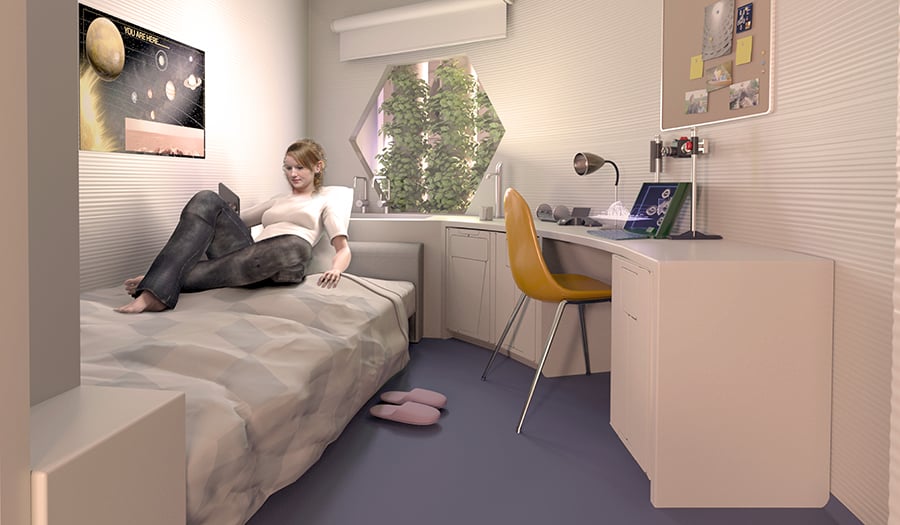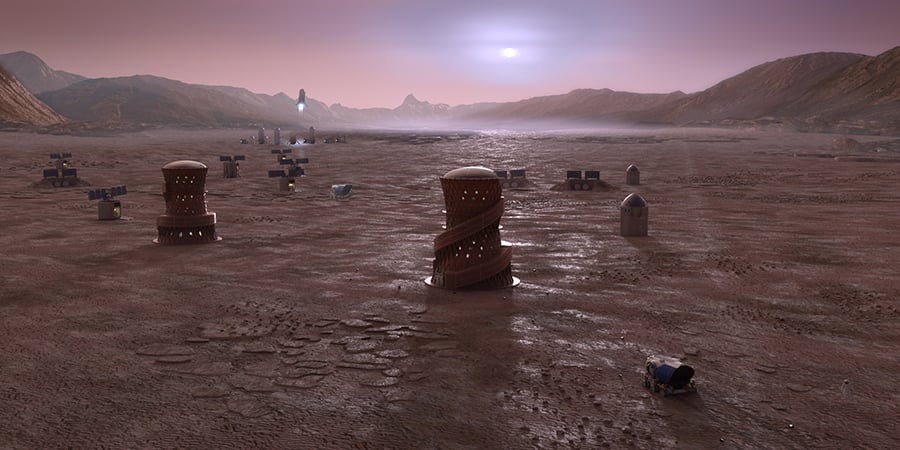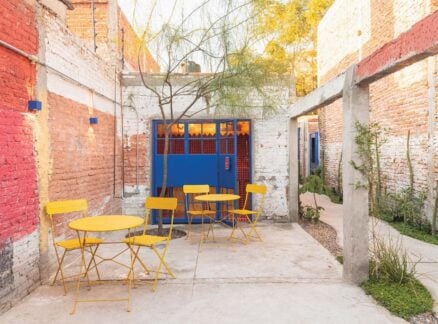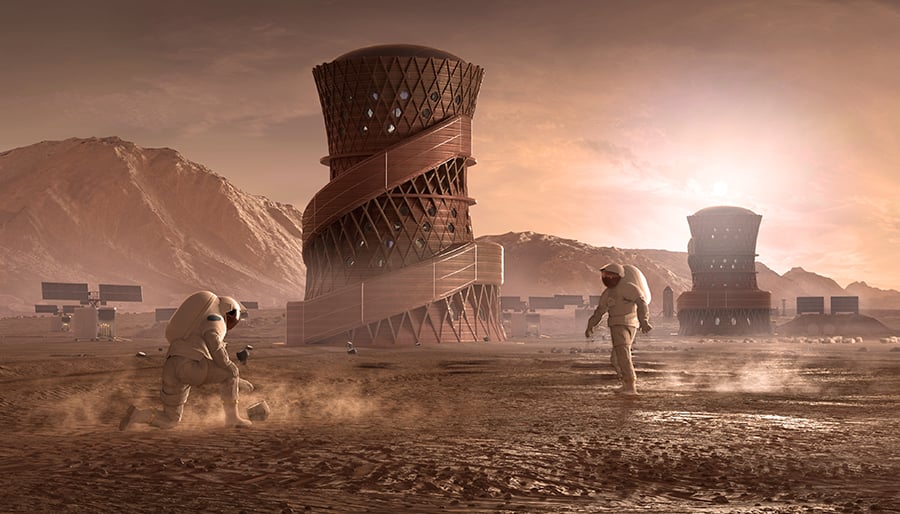
July 8, 2019
NASA Names Winner of 3D-Printed Mars Habitat Challenge
Design studio SEArch+ and robotics company ApisCor won the multi-stage competition’s “Virtual Construction Level,” designing a hyperboloid dwelling that integrates radiation protection with crucial life support systems.

As NASA’s Curiosity Rover forges on in its quest to discover signs of life on Mars, architects and designers are devising ways for humans to inhabit the Red Planet. Since 2015, NASA has hosted the ongoing, multi-phase 3D-Printed Habitat Challenge to help devise a sustainable research outpost on Mars that could accommodate a four-person crew for one Earth year. In the recent software-modeling stage of the competition, design studio SEArch+ and robotics company ApisCor won first place for their proposal Mars X House V2.
“In many ways, [space habitats are] like the cathedral building of our time,” says SEArch+ cofounder Melodie Yashar. “[They] will stand as a great expression of our collective humanity.” According to Yashar, the winning X House prototype represents the seeds of a fully autonomous construction process that integrates precision-manufactured elements from Earth with buildings 3D-printed on-site using Martian regolith and basalt igneous rock. Unlike the master masons of the Middle Ages, though, the New York studio was tasked with designing a closed-loop system that could contend with issues in the Martian environment including pressurization, radiation, and toxic dust.
“Every element of the habitat is based on extensive research to achieve the best possible outcome,” says SEArch+ member Rebeccah Pailes-Friedman. This approach is apparent in the numerous health and safety precautions that guided much of the habitat’s design.
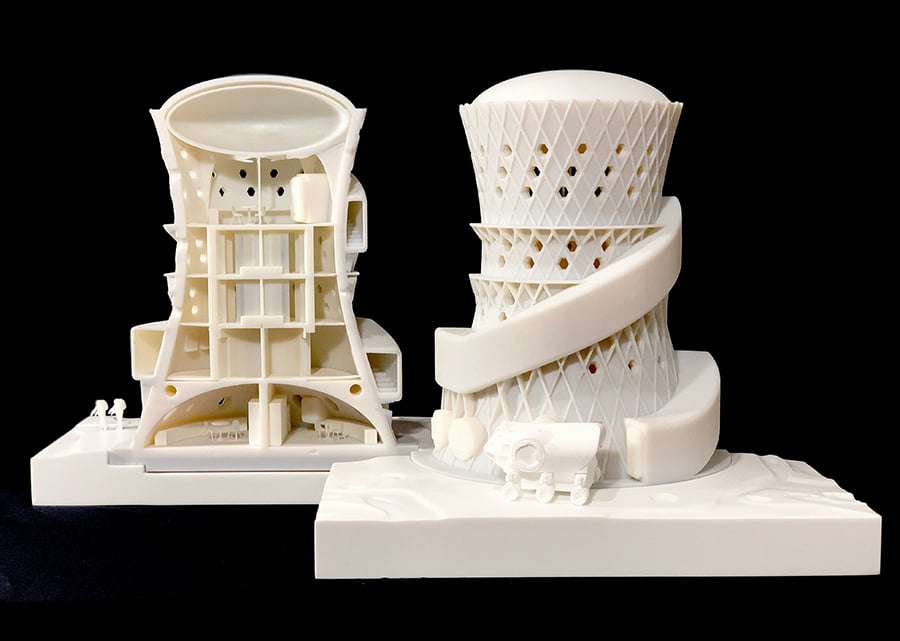
The most distinctive aspect of X House is its hyperboloid shape, which provides structural resistance against the outward force of air. Though it bears a certain resemblance to Konstantin Melnikov’s Constructivist house in Moscow, the geometry is actually drawn from engineering precedent set by arch-gravity dams and nuclear cooling towers. Deep, hexagonal windows allow in light up to 30 degrees in altitude, shielding the interior from harsh overheard radiation. Use of the interior space is divided according to how many hours per day the crew is expected to spend in each section—for example, the crew’s sleeping quarters are located in X House’s center, where radiation levels are at their lowest.
Crucially, humans inhabiting extraterrestrial bodies for extended periods of time must be able to produce their own breathable air and potable water. (Such considerations led NASA to pre-select the Erebus Montes mountain region as a potential landing site; the presence of subsurface ice there could provide a future crew with water for both construction and consumption.) Emulating the vertical organization of a water tower, this supply would be stored in a reservoir at the very top of X House, where it can also function as a radiation buffer. From there, water flows downward through a plant-wall system that rapidly replenishes oxygen levels. In addition to the regenerative nature of these greenhouse systems, Yashar emphasizes the important impact of plants on the crew’s psyche: “The inclusion of a biodiverse ecological approach to a habitat is something we are interested in…for the very real human factor that we want to bring a piece of earth with us.”
Though the competition is designed to advance the development of sustainable dwellings on Mars and beyond, it also has the potential to influence many aspects of construction back on Earth. “The core questions asked of ‘space habitats’ and other architectural design project types are the same: they are—or should be—all human-centered and support the surrounding environment,” says SEArch+ member Michael Morris. Like the lasting impact of the Earthrise photograph taken in 1968 during the Apollo 8 mission to the moon, the discoveries and innovations made in the process of settling Mars will ultimately reveal something about the environment on our home planet—built and natural alike.
You may also enjoy “New David Chipperfield–Designed Addition to Berlin’s Museum Island Set to Open.”
Would you like to comment on this article? Send your thoughts to: [email protected]




